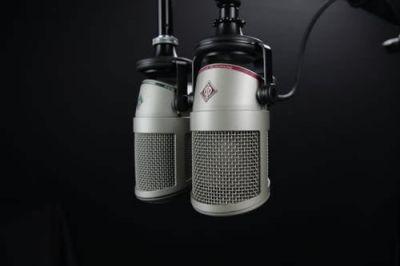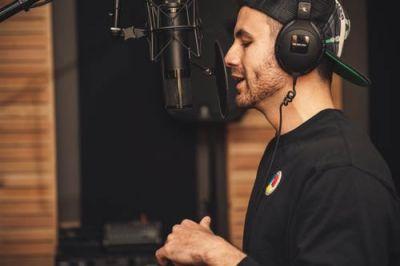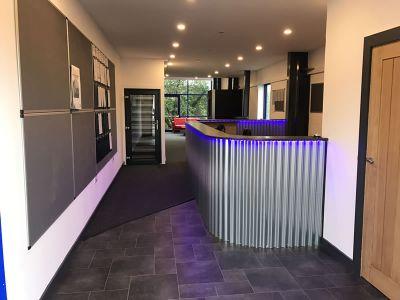Manufacturers of Vocal Booths
and Sound Isolation Enclosures
UK Freephone: 0800 170 1271
International: +44 (0) 7300 332 268
Email: Sales@kubevocalbooth.com
Follow Us:
Audio Booths & Audio Sound Isolation Enclosures

The latest digital recording equipment is extremely accurate at capturing audio reproduction with outstanding results, however, clients tell us that it is also extremely accurate at capturing background noises.
There are many tips for obtaining better audio in digital production including having the right microphone for the job but in essence it is paramount you have a suitable audio booth.
A Kube audio sound isolation booth will greatly assist in capturing crisp, vivid audio reproduction by isolating the audio content from external interfering noises.
All Kube audio sound isolation enclosures are fully relocatable so if your circumstances change and you need to move location, you can rest assured you don't have to purchase again.
The Kube audio booths provide a controlled acoustic environment at a low cost and the modular compact design means that the booth components will fit through any standard doorway.
Optional castors can be supplied to make the isolation booth completely mobile.
Audio recording is used for a variety of purposes across many different industries. Here are some common uses of audio recording:
1.Music production: Audio recording is an essential component of music production, allowing musicians to capture their performances and create high-quality recordings that can be shared with audiences. Musicians may record their performances in a studio or live setting and then edit and mix the recordings to create a final product.
2.Film and video production: Audio recording is a critical element of film and video production, allowing filmmakers to capture dialogue, sound effects, and music. In film production, audio is typically recorded separately from the visual elements of a scene and then synced up in post-production.
3.Podcasting: Audio recording is an essential component of podcasting, which has become a popular form of digital media in recent years. Podcasters use audio recording equipment to capture their voices and the voices of their guests, which are then edited and mixed to create a finished podcast episode.
4.Radio broadcasting: Audio recording is a crucial component of radio broadcasting, allowing radio hosts to capture their voices and create radio shows that can be broadcast to audiences. In radio broadcasting, audio may be recorded live or pre-recorded and edited before being broadcast.
5.Voiceover work: Audio recording is used extensively in voiceover work, which involves recording voice performances for use in a variety of media, including commercials, video games, and animated films.
6.Sound design: Audio recording is an essential component of sound design, which involves creating and manipulating sounds to enhance the emotional impact of films, television shows, and video games.
7.Educational purposes: Audio recording is also used for educational purposes, such as recording lectures, speeches, and seminars. These recordings can be used to provide students with a way to review the material or to share information with a wider audience.

All in all, audio recording is used in a wide range of applications across many different industries, from music production and film to podcasting and education. The ability to capture and manipulate sound has revolutionized many industries and has become an essential component of modern media production.
Recording audio is a crucial aspect of the music and media industry. It allows musicians, podcasters, filmmakers, and other content creators to capture high-quality sound that can be edited and mixed into a finished product. However, capturing good audio can be a challenging task, and it requires proper equipment, techniques, and environment to achieve the desired results. One way to ensure high-quality recordings is by using a sound booth.
A sound booth, also known as an isolation booth or vocal booth, is a small, enclosed space designed for recording sound.
It is typically made of sound-absorbing materials such as foam, acoustic insulation rubber barriers and acoustic panels that reduce reflections and absorb unwanted noise. The purpose of a sound booth is to isolate the sound source from external noise and to control the acoustics of the recording environment.
Sound booths are incredibly useful for recording for several reasons. First and foremost, they provide a controlled recording environment. By isolating the sound source from external noise, sound booths ensure that unwanted sounds do not interfere with the recording. This can include ambient noise such as traffic, wind, or people talking, as well as mechanical noise such as air conditioning, ventilation systems, or electrical hums. A sound booth also helps to eliminate echoes and reverberations, which can occur when sound waves bounce off hard surfaces such as walls, floors, and ceilings. By reducing these reflections, sound booths provide a more natural and neutral sound that is easier to mix and edit.

Another benefit of sound booths is that they improve the quality of the recording. When recording in an untreated room, sound waves can bounce around, causing frequency build up and cancellation, resulting in a muddy or boomy sound. However, sound booths are designed to absorb and diffuse sound waves, resulting in a more even frequency response. This means that the recorded sound is clearer, more focused, and easier to work with in post-production.
Additionally, sound booths provide privacy and comfort for the recording process. In a recording studio or home recording setup, it can be challenging to find a quiet and private space to record, especially if multiple people are involved. A sound booth allows the performer to focus on their performance without distraction or interruption, as well as providing a comfortable and controlled environment to work in.
There are different types of sound booths available depending on the intended use. For example, a vocal booth is designed specifically for recording vocals and spoken word, while an instrument booth is used for recording acoustic or electric instruments. Some sound booths are portable and can be easily moved from one location to another, while others are permanent installations that are built into a studio or home. See our sound isolation booths or vocal booths for portable options and our soundproof music rooms and recording studios for a permanent option.
To achieve the best results when recording in a sound booth, it is important to use proper recording techniques and equipment. This includes using high-quality microphones, headphones, and audio interfaces, as well as setting up the recording space to minimize reflections and standing waves. It is also essential to properly position the microphone and the performer to capture the desired sound and to avoid picking up unwanted noise or reflections.
In conclusion, recording audio is a critical aspect of the music and media industry, and sound booths are an essential tool for achieving high-quality recordings. By providing a controlled recording environment, isolating the sound source from external noise, and improving the quality of the recording, sound booths ensure that the final product is clear, focused, and professional. Whether you are a musician, podcaster, filmmaker, or content creator, investing in a sound booth can make a significant difference in the quality of your recordings.